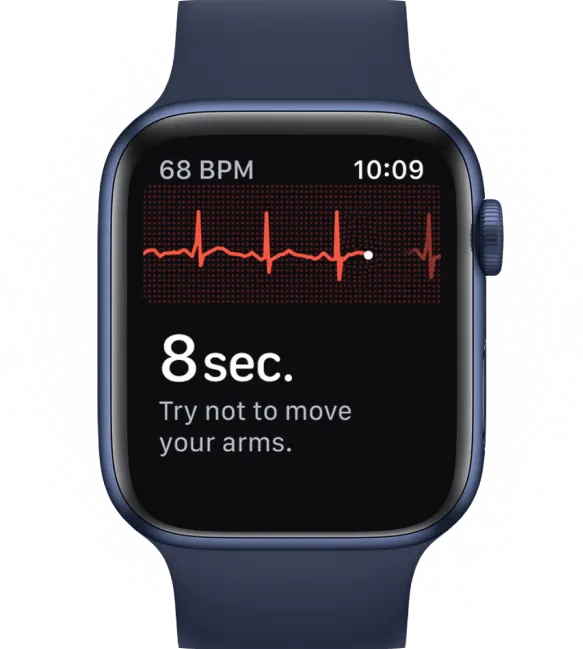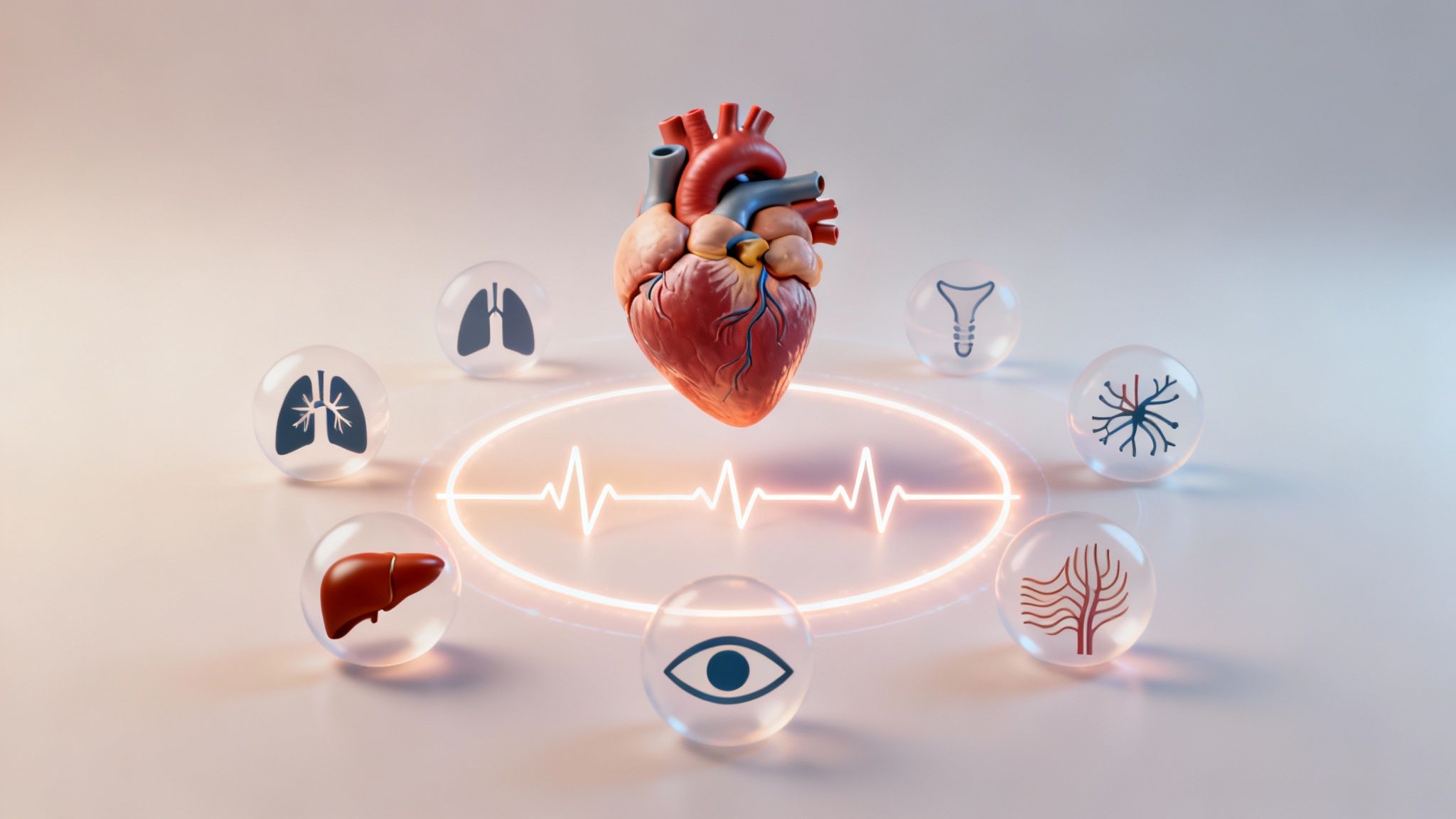Key Takeaways
Hello Heart Hero. We get it. Starting a powerful heart medication like amiodarone can feel like a big deal, especially when you start reading about potential side effects. But you've already taken an important first step by looking for clear, straightforward information. That's something to be proud of.
Your Guide to Understanding Amiodarone Treatment
Think of this guide as your partner. We'll walk through everything you need to know about amiodarone, but without the confusing medical jargon. We’ll explore the side effects together, from the more common ones to the important signs you need to watch for.
Our goal is to give you the knowledge you need to feel more in control of your treatment and have better, more confident conversations with your doctor. Consider this a roadmap for your health journey, designed to bring clarity and ease your mind.

Why This Medication Can Feel Different
Amiodarone is a heavy-hitter for managing serious heart rhythm problems, but it works in a unique way. Unlike drugs that target one specific pathway, amiodarone has a broad effect on your body. This is what makes it so effective, but it's also why it comes with a wider range of potential side effects.
It also stays in your system for a very long time, which means its effects can be slow to show up and slow to go away. This isn't a reason for alarm, but it does highlight why staying informed and in close contact with your healthcare team is so crucial. Your awareness is truly your best asset here.
Understanding the Numbers Behind the Side Effects
When exploring information about amiodarone, you might encounter some concerning statistics. It's essential to understand these figures within their proper context. Information from the FDA Adverse Event Reporting System spanning 2004 to 2024 recorded 8,220 adverse events associated with the oral form of this medication. Additionally, it was noted that 45.9% of these events occurred in patients aged 65 to 85. Further insights into these amiodarone findings are available on Frontiers in Pharmacology.
These figures simply show what has been reported, not what every single person will experience. What they really do is underscore the importance of regular monitoring, especially for certain age groups, and working hand-in-hand with your doctor to find the right balance for your health.
This guide is here to turn statistics into understanding. Our goal isn't to list every possibility to create worry, but to explain the most important ones so you can become a proactive partner in your own care.
We'll cover these key areas to help you feel prepared:
- Common and Manageable Effects: We'll start with the things you might notice first, like sun sensitivity or minor vision changes, and discuss practical ways to handle them.
- Serious Signs to Watch For: Knowledge is power. We’ll clearly explain the important symptoms related to your lungs, thyroid, and liver that mean it's time to call your doctor.
- Heart-Specific Interactions: We will demystify how amiodarone affects your heart's electrical system, including ECG changes your doctor monitors.
- Proactive Health Monitoring: You'll learn about the simple, routine checks that ensure the medication is working safely for you over the long term.
Understanding Common and Manageable Side Effects
Let's start with the side effects you're most likely to notice. Starting any new medication is a bit like getting used to a new routine; there are always a few quirks to learn. Amiodarone is no different, and understanding its more common effects can help you feel prepared and less anxious.
These effects are often quite manageable and not usually a cause for alarm. Think of them as your body’s way of adjusting to the new medicine.

Changes You Might See or Feel
Some of the most frequently discussed side effects of amiodarone involve your skin, eyes, and even your nervous system. A key thing to know about amiodarone is that it likes to stick around in your body's tissues for a long time. This is exactly what makes it so effective for your heart, but it's also why you might see changes in other parts of your body.
Two of the most well-known skin-related effects are:
- Sun Sensitivity (Photosensitivity): This is a very common one. You might find your skin burns much more easily than it used to. A good, high-SPF sunscreen, protective clothing, and a wide-brimmed hat will quickly become your best friends when you're outside.
- Blue-Gray Skin Discoloration: This effect is less common and tends to develop after long-term, high-dose use, typically showing up in sun-exposed areas. While it can be visually surprising, it's generally harmless and often fades very slowly if the medication is stopped or the dose is lowered.
Demystifying Vision Changes
Your eyes are another place where amiodarone can leave its mark, but it’s important to understand what these changes actually mean. The most common effect is the development of tiny deposits in the cornea, which is the clear outer layer of your eye.
These deposits, known as corneal microdeposits, sound serious but are almost always harmless. They typically don't affect your vision at all. A small number of people might notice seeing halos around lights at night, but it's rarely a reason to stop the medication.
Corneal microdeposits develop in nearly 100% of patients after a month or two of treatment and are generally considered asymptomatic. Corneal opacities refer to cloudiness or haziness that affects the cornea, the clear front surface of the eye. This condition can occur in 50% to 60% of patients, often without affecting their vision. Although uncommon, more severe complications such as damage to the optic nerve can develop, highlighting the importance of routine eye check-ups.
When Your Nerves Feel the Effects
You might also notice some subtle neurological symptoms. These can feel a bit strange, but they are often just part of the body's response to the medication. Neurological side effects can show up in anywhere from 3% to 30% of people taking amiodarone.
Some common neurological signs include:
- Tremors: A slight shakiness, often in your hands or limbs.
- Unsteadiness or Ataxia: Feeling a bit wobbly on your feet or having trouble with coordination.
- Neuropathy: A sensation of tingling or numbness, which you might feel in your hands or feet.
It's important to report these symptoms to your doctor. They can help figure out if the medication is the cause and how to best manage them. If you're interested in a broader view, you might find our guide on the side effects of different antiarrhythmic drugs helpful.
Being aware of these common possibilities takes away the element of surprise. It lets you observe your body with calm awareness, knowing what to look for and when it's time to have a conversation with your healthcare team. The goal is to manage these quirks together, ensuring the medication helps your heart without causing unnecessary disruption to your life.
Recognizing Serious Side Effects That Need Action
Now, let's talk about the more serious, though less common, side effects of amiodarone. This isn't about creating fear; it's about giving you the knowledge to act. Being prepared and knowing the warning signs is one of the most powerful tools you have to protect your health.
We will focus on three key areas of concern: your lungs, your thyroid, and your liver. Understanding these potential issues helps turn anxiety into awareness, allowing you to partner with your doctor and act quickly if needed.

Listening to Your Lungs
One of the most important side effects to watch for is something called amiodarone-induced pulmonary toxicity. This is a serious condition where the medication causes inflammation or scarring in the lungs. It can happen at any time but is more common with long-term use.
Imagine your lungs are like delicate sponges. This condition makes them stiff and less efficient at absorbing oxygen. That's why the symptoms often feel like your breathing is being restricted.
It’s essential to contact your doctor immediately if you notice any of these signs:
- A new, persistent, dry cough that doesn't seem to go away.
- Shortness of breath, especially with activity you could previously handle easily.
- Chest pain or discomfort that worsens when you take a deep breath.
- Unexplained fever that isn't from a cold or flu.
Catching these symptoms early makes a huge difference. Your doctor will likely order tests like a chest X-ray to see what’s going on. The good news is that if it's caught in time, stopping the medication can often halt or reverse the problem.
Watching Your Thyroid Health
Amiodarone contains iodine, a key building block for thyroid hormones. Because of this, it can sometimes throw your thyroid gland off balance, making it either underactive (hypothyroidism) or overactive (hyperthyroidism).
Think of your thyroid as your body's thermostat. When it’s working correctly, your energy levels, metabolism, and even your heart rate are well-regulated. When it’s out of sync, you’ll feel it.
An underactive thyroid (hypothyroidism) might make you feel like your body is slowing down. Look for deep fatigue, unexpected weight gain, feeling cold all the time, or increased constipation.
An overactive thyroid (hyperthyroidism) can feel like your body is in overdrive. You might experience unexplained weight loss despite a good appetite, a racing heart, anxiety, tremors, or trouble sleeping.
These symptoms can be subtle at first, so it’s important to pay attention to any persistent changes in how you feel. Your doctor will be monitoring your thyroid levels with regular blood tests, but your own observations are just as valuable.
Protecting Your Liver
Your liver is your body’s main filter, and amiodarone is one of the many things it has to process. In some people, this can cause irritation or inflammation in the liver, which may show up as elevated liver enzymes on a blood test.
Most of the time, this is a mild issue that your doctor can manage by adjusting your dose. It often doesn't cause any noticeable symptoms, which is why routine blood work is a non-negotiable part of amiodarone therapy.
However, in rare cases, more significant liver injury can occur. It’s important to be aware of the signs, even though they are uncommon.
- Yellowing of the skin or eyes (jaundice)
- Dark-colored urine
- Loss of appetite or nausea
- Pain or discomfort in the upper right side of your abdomen
If you experience any of these symptoms, you should seek medical attention right away. Remember, these serious side effects of amiodarone are not the norm, but being informed is your best defense. It empowers you to notice changes early, communicate clearly with your healthcare team, and ensure this powerful medicine continues to work for you, safely.
How Amiodarone Interacts With Your Heart
It’s a fair question: how can a drug designed to fix an arrhythmia also cause heart-related side effects? This is a common and totally understandable concern. The answer lies in how amiodarone works its magic.
Amiodarone’s main job is to calm the overactive electrical signals that throw your heart into a dangerous rhythm. It does this by acting on several electrical pathways inside your heart's muscle cells. This action slows everything down and makes the heart muscle less excitable, exactly what you need to get back to a normal, steady rhythm.
But sometimes, this powerful calming effect can be a little too much of a good thing. The very same action that quiets a chaotic rhythm can also slow down a normal one a bit too much.
When Your Heart Rate Slows Down Too Much
One of the most common cardiac side effects of amiodarone is a slow heart rate, a condition your doctor might call bradycardia. While a slightly lower heart rate often means the medication is doing its job, it becomes a problem if it dips too low.
This happens to about 5% of people taking amiodarone long-term. When your heart beats too slowly, it struggles to pump enough oxygen-rich blood to your body and brain, which can lead to symptoms like:
- Dizziness or feeling lightheaded
- Deep fatigue and weakness
- Shortness of breath
- Fainting spells
Your doctor keeps a close eye on this by checking your pulse during appointments and reviewing your ECGs. If your heart rate gets too slow, they might adjust your dose or look at other options.
Understanding Changes on Your ECG
Your doctor uses an electrocardiogram (ECG or EKG) to get a picture of your heart's electrical activity. Amiodarone causes predictable changes on an ECG, which are actually signs that the drug is active in your system. One of the key things they watch for is called QTc prolongation.
That term sounds way more complicated than the concept actually is.
Think of your heartbeat as a two-step process: the heart muscle contracts (the beat), and then it has a brief "recharge" period before the next beat. The QTc interval on your ECG is simply a measurement of how long that recharge time takes. Amiodarone can make this recharge period a little longer.
A slightly longer QTc is an expected, and usually safe, effect of the medication. The issue is when that interval gets too long, as it can increase the risk of a rare but very serious type of arrhythmia.

This is exactly why your doctor will get a baseline ECG before you start amiodarone and check it regularly afterward. They are carefully measuring this interval to make sure it stays in a safe zone. If you're interested in why this is such a focus in heart care, you can learn more about other common drugs that cause QT prolongation.
This isn't about expecting a problem; it's about preventing one. Understanding what your doctor is looking for on your ECG helps you become a more informed partner in your own care. You can see these check-ups for what they are: a proactive way to ensure amiodarone is helping you in the safest way possible.
Staying Proactive With Health Monitoring
Taking an active role in your health is the single best way to use amiodarone safely and effectively for the long term. This isn't about waiting for a problem to appear; it's about staying ahead of the game. Think of monitoring as a collaborative effort, a partnership between you and your healthcare team to ensure this powerful medicine is your ally.
Your Typical Monitoring Schedule
While your doctor will create a plan specific to you, a standard monitoring schedule for amiodarone often looks something like this. Understanding the "why" behind each test can transform it from a chore into an act of self-care.
Your regular check-ins will likely include:
- Blood Work: These tests are usually done every six months. They check your liver function (to catch any irritation early) and your thyroid levels (to ensure it hasn't become over or underactive).
- Chest X-ray: You'll typically get a baseline X-ray before you start and then another one once a year. This allows your doctor to see a clear picture of your lungs and spot any early signs of inflammation.
- ECG (Electrocardiogram): Your doctor will monitor your heart's electrical activity regularly to check your heart rate and your QTc interval, making sure they both stay within a safe range.
- Eye Exams: An annual visit to the eye doctor is recommended to check for the harmless corneal deposits and, more importantly, to rule out any rare effects on your optic nerve.
The Power of Paying Attention
Medical tests are just one part of the equation. Your daily observations are equally, if not more, important. You are the expert on your own body, and noticing small shifts is a skill you can build.
Your body gives you signals every day. The key is to learn how to listen to them with calm awareness, not with fear. Keeping a simple log of symptoms can be incredibly helpful for your doctor's appointments.
A simple checklist to track can make your appointments more productive:
- Breathing: Have you noticed any new shortness of breath or a dry cough?
- Energy Levels: Are you feeling unusually tired or, conversely, wired and anxious?
- Vision: Any blurriness, halos around lights, or changes in your sight?
- Balance: Have you felt any new dizziness, unsteadiness, or tremors?
By tracking these things, you come to your appointments with clear, specific information. This empowers you and your doctor to make the best decisions together. If you'd like to dive deeper into how technology can help, you might be interested in our guide on what is cardiac monitoring.
Minimizing Risks With Dosing and Drug Interactions
One of the best ways to manage amiodarone's side effects is through smart dosing and being vigilant about how it interacts with other drugs. Your doctor's prescription plan isn't random; it's a careful balancing act to get your heart the maximum benefit with the minimum risk.
This is why your treatment probably started with a “loading dose.” Think of it like priming a pump. A higher dose at the beginning helps build up the medication in your system quickly to get your heart rhythm under control. After that initial phase, you’ll move to a much lower “maintenance dose” for the long haul.
Finding the Sweet Spot With Your Dose
The goal is always to find and use the lowest dose that still works effectively. Simply lowering the dose is a primary strategy for keeping side effects at bay, and the research backs this up, showing a clear connection between the daily dose and the risk of adverse effects.
One major review found that at a dose of 200 mg per day, about 17% of people experienced side effects. But when the dose was cut in half to 100 mg per day, that number dropped significantly to just 11%.
Even more telling, the rate of side effects serious enough to make someone stop the medication fell from 6% down to only 2% at the lower dose. You can see the details on low-dose amiodarone safety for yourself. It’s a powerful reminder of how impactful even small dose adjustments can be.
Your doctor's plan to start high and then taper down is a standard, safety-first strategy. It’s all about gaining control quickly and then maintaining it as gently as possible.
This careful management is precisely why it’s so important to speak up about any new symptoms you feel. Your feedback is the key piece of information your doctor needs to fine-tune your dose and find that perfect balance for your body.
Navigating Common Drug Interactions
Amiodarone is a bit of a social butterfly in the world of medications; it interacts with a lot of other drugs. Because it's processed by the liver using specific enzyme pathways, it can easily interfere with how your body handles other common prescriptions. This is why giving your doctor a complete list of everything you take isn't just a good idea, it's a critical safety step.
Here are some of the most important interactions to watch out for:
- Blood Thinners: Amiodarone can dramatically boost the effects of warfarin (Coumadin), which seriously increases the risk of bleeding. Your doctor will need to monitor your blood work very closely and will almost certainly need to lower your warfarin dose.
- Statins: Certain cholesterol drugs, like simvastatin (Zocor), can build up to much higher levels in your body when taken with amiodarone. This raises the risk of muscle pain and other serious muscle-related side effects.
- Other Heart Medications: Drugs like digoxin, as well as certain beta-blockers or calcium channel blockers, can have their effects amplified. This can be a problem, potentially slowing your heart rate down to unsafe levels.
- Grapefruit Juice: This is a big one and a non-negotiable. Grapefruit blocks the enzyme that breaks down amiodarone, which can lead to dangerously high levels of the medication in your bloodstream. It’s best to avoid it completely.
Being your own best advocate means keeping an up-to-date list of all medications, supplements, and even over-the-counter products you use. Share it with both your doctor and your pharmacist so they have the full picture. This simple habit helps them protect you from harmful interactions and manage your amiodarone therapy safely and effectively.
Your Questions About Amiodarone Answered
It's completely natural to have a few more questions pop up as you digest all this information. Being an active participant in your own health means getting clear on the specifics. To help you out, we've put together some answers to the most common concerns people raise about amiodarone.
How Long Before Side Effects Appear?
That's a fantastic question, but unfortunately, there’s no one-size-fits-all answer. The timeline for side effects is all over the map.
Some effects, like becoming more sensitive to the sun, can show up pretty quickly. Others, such as thyroid problems or the tell-tale blue-gray skin discoloration, are more often tied to long-term use and might not appear for months or even years.
On the other hand, the tiny, harmless deposits in the eyes (corneal microdeposits) pop up in nearly everyone within just a couple of months. The single most important takeaway is this: report any new or unusual symptom to your doctor, no matter how long you've been taking the medication.
Are Amiodarone Side Effects Reversible?
Many of them are, which is great news. The catch is that amiodarone sticks around in your body for a very, very long time, so reversing its effects can be a slow-moving process. Thyroid issues often get better after stopping the drug, and skin discoloration can fade over time.
But it’s crucial to understand that some of the most serious effects, especially significant lung damage (pulmonary fibrosis), may not be fully reversible. This is precisely why regular check-ins and catching potential problems early is so vital for your long-term health.
Can I Drink Alcohol While Taking Amiodarone?
This is the perfect question to bring directly to your doctor, since everyone's health situation is different. Generally speaking, it's wise to be cautious here.
Both alcohol and amiodarone are processed by your liver. Combining them could put extra strain on your liver and increase the risk of damage. Your doctor can give you personalized advice based on your liver function tests and overall health. When you're managing a long-term medication like amiodarone, clear communication with your healthcare team is everything. For some general pointers, check out these tips for asking your pharmacist the right questions.
With the Qaly app, you can get your wearable ECGs analyzed by certified experts in minutes, tracking your rhythm and key intervals like QTc.










.png)
.png)